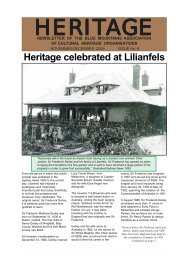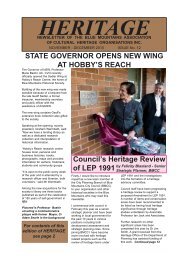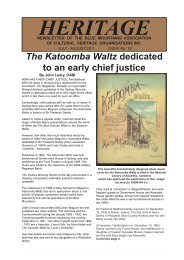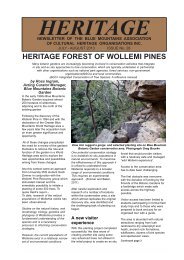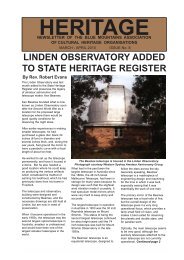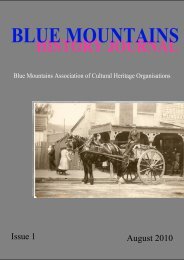Newsletter No. 15 - Blue Mountains Association of Cultural Heritage ...
Newsletter No. 15 - Blue Mountains Association of Cultural Heritage ...
Newsletter No. 15 - Blue Mountains Association of Cultural Heritage ...
You also want an ePaper? Increase the reach of your titles
YUMPU automatically turns print PDFs into web optimized ePapers that Google loves.
AT 86 NORMAN LINDSAY DESIGNED<br />
SPRINGWOOD’S TOWN CREST<br />
By Shirley Evans, Springwood<br />
Historians<br />
It was 1965 and, at last, Springwood was to have a hall!<br />
Designed by local architect and World War II veteran,<br />
Eric Skarrat, and built by Alec Gall Constructions Pty<br />
Ltd, it was begun in February, 1965 and completed in<br />
February, 1966.<br />
The people <strong>of</strong> Springwood had long felt the need for a<br />
hall.<br />
William Rayner , one <strong>of</strong> the earliest general store<br />
proprietors, set up his extensive business in about<br />
1877. His store had a large room attached to it and this<br />
became known as Rayner’s Hall.<br />
Here despite its inadequate size, most <strong>of</strong> the meetings<br />
and gatherings <strong>of</strong> the town were held – the Progress<br />
Committee, various lodges, political gatherings, the<br />
Literary and Debating Club, church services, concerts.<br />
This continued until 1893 when William found he<br />
needed the extra space for his business.<br />
Gustav Larsen and his nephew, Axel Bech, Sydney<br />
tobacconists, had a holiday home, Elsinore, in<br />
Macquarie Rd which had a billiard room and they kindly<br />
<strong>of</strong>fered this for community use.<br />
The Royal Hotel also hosted meetings.<br />
William Honeysett, another general storekeeper, built a<br />
fairly large hall (66ft x 30ft) in 1909 which included a<br />
refreshment room. This burnt down together with the<br />
shops around it in 1921.<br />
The Springwood School <strong>of</strong> Arts was opened in 1913 but<br />
it was not suitable for dances or balls having only a<br />
library, <strong>of</strong>fice space and a large billiard room.<br />
Meetings were sometimes held there but nothing on a<br />
large scale.<br />
Both during and after World War I Springwood people<br />
began campaigning and fund raising to build a War<br />
Memorial Hall but this came to nothing.<br />
In 1923 an open air theatre was built in Macquarie Rd<br />
by Harry Williams.<br />
It was known first as the Springwood Theatre, then the<br />
Plaza and finally the Roxy.<br />
It had seating for 450 people and could be used for<br />
dances and balls when it was later ro<strong>of</strong>ed. Made <strong>of</strong><br />
corrugated iron, it was not a beautiful building but could<br />
be decorated with a bit <strong>of</strong> imagination.<br />
But now in 1965 the town was actually getting a<br />
purpose built, architect designed hall. 1965 also<br />
happened to be the <strong>15</strong>0 th anniversary <strong>of</strong> the naming <strong>of</strong><br />
Springwood by Governor Lachlan Macquarie.<br />
Springwood’s town crest on the wall <strong>of</strong> Springwood<br />
Civic Centre. Photograph courtesy John Merriman.<br />
The Springwood Chamber <strong>of</strong> Commerce decided it was<br />
a propitious time for the town to have its own coat <strong>of</strong><br />
arms which could then be permanently displayed in the<br />
new hall.<br />
Bruce Jackson, son <strong>of</strong> Joseph Jackson MLA and<br />
proprietor <strong>of</strong> the Stonewall Jackson store in Macquarie<br />
Rd suggested that respected local artist, <strong>No</strong>rman<br />
Lindsay, who had been a Springwood resident since<br />
1913 and was still an active creative artist at the age <strong>of</strong><br />
86, should be asked to design the coat <strong>of</strong> arms.<br />
The Macquarie Historical Society (now known as the<br />
Springwood Historical Society) <strong>of</strong> which Bruce Jackson<br />
was a member enthusiastically adopted the idea and<br />
<strong>No</strong>rman Lindsay agreed to create the design.<br />
He painted in water colours a coat <strong>of</strong> arms with a<br />
central figure <strong>of</strong> a lyre bird with tail spread and crowned<br />
with a waratah.<br />
Lyre birds were commonly found in the Springwood<br />
bush and were actually bred in captivity by Jack Coyle<br />
who lived in Raymond Rd Springwood in the 1930s. He<br />
had a licence to do so.<br />
The waratah was also commonly found in the<br />
Springwood bush and was frequently plundered by<br />
tourists to the area.<br />
On one side <strong>of</strong> the lyre bird was an aboriginal man<br />
holding spears who represented the first inhabitants <strong>of</strong><br />
the region and on the other side was a white man<br />
representing the contribution <strong>of</strong> explorers to the <strong>Blue</strong><br />
<strong>Mountains</strong>.<br />
HERITAGE 6<br />
May - June 2011




